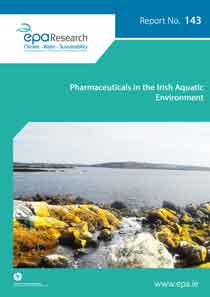Summary: The overall aim of this project was to combine chemical and biological analyses in an integrated assessment of the extent and the effects of pharmaceutical pollution in the Irish aquatic environment, with the ultimate aim of developing a simple bioassay for the fast, reliable identification and toxicological assessment of pharmaceuticals in environmental samples.

1 Background
In March 2008, the Irish Environmental Protection Agency (EPA) funded a 5-year research project The Assessment and Potential Human Impact of Exposure to Environmental Contaminants on Marine and Freshwater Bivalves (2007-DRP-3-S5) under the Science, Technology, Research and Innovation for the Environment (STRIVE) Developing Environmental Research Potential (DERP) scheme. This project specifically investigated pharmaceuticals as environmental contaminants of emerging concern and arose out of the lack of research on their presence in and potential impact on the Irish aquatic environment.
Internationally, pharmaceuticals have recently become the object of considerable attention and concern due to their possible toxicity and potential to cause adverse effects in aquatic organisms and the potential for direct human exposure via ingestion of contaminated seafood.
To assess the impact of a pollutant on the environment, both chemical (to identify the compounds and calculate their concentration) and biological analyses (to investigate their toxicity potential) must be undertaken. This project is therefore divided into two broad areas – chemistry and biology. The overall aim of this project was to combine chemical and biological analyses in an integrated assessment of the extent and the effects of pharmaceutical pollution in the Irish aquatic environment, with the ultimate aim of developing a simple bioassay for the fast, reliable identification and toxicological assessment of pharmaceuticals in environmental samples.
2 Objectives
3 Key Outputs
Although a previous EPA-funded study had reported the presence of pharmaceuticals in municipal effluents1, the current study is the only report on the spatial occurrence and relative distribution of pharmaceutical residues in the Irish marine environment and their bioaccumulation potential.
The information gathered using the developed analytical techniques has enhanced Ireland’s capacity towards the integrated monitoring of contaminants in the marine environment and these findings will contribute to future pharmaceutical fate studies and evaluations of the human risks posed by these emerging environmental pollutants. The scope of the biological assessment presented in this report has provided vital knowledge of the potential toxic effects of pharmaceuticals on non-target aquatic organisms. The information gathered using biomarker techniques has also enhanced Ireland’s capacity towards integrated pollution monitoring, providing valuable baseline data on biomarker responses.
Although not yet validated, the use of human diagnostic techniques for environmental assessment has shown promising results, with the ability of these technologies to cross-react and measure the appropriate end points in various aquatic species, offering a potentially useful tool for environmental monitoring.
https://www.epa.ie/media/epa-2020/publications/research/Research-Report-143-thumb[1].jpg